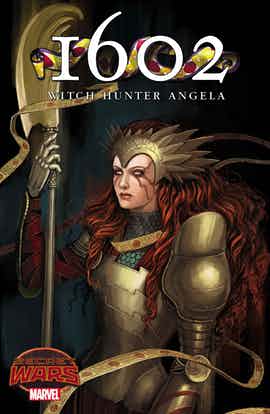
Some series skate around their genre, downplaying and softening anything that could seem strange, but “1602 Witch Hunter Angela” #1 embraces its historical fantasy premise with open, elaborately armored arms. From Marguerite Sauvage’s inviting court farces to Stephanie Hans’ magnetic, dark monsters, this is a fully and exuberantly imagined issue. Despite a tonal shift between Kieron Gillen and Marguerite Bennett’s sections that will jar some readers, “1602 Witch Hunter Angela” #1 is a gorgeous, vivid read.
The two-story structure hasn’t always worked smoothly in “Angela: Asgard’s Assassin” but, in this issue, it reads winningly. After a dark opening page, the story transitions to Windsor Castle. Angela and Serah, hunters of the “Witchbreed,” arrive to see the King, and things proceed rather unexpectedly from there. The physicality in Sauvage’s artwork almost approaches farce. Lord Essex’s cries of “Regicide! Traitor! Heresy!” are accompanied by cartoonishly distressed facial expressions and an attacking monster is spittooned on Angela’s halberd like an angry prawn on a fork. Combined with the lighter, almost pastel color scheme, the artwork is a perfect match for a script that includes the pun “you bubonic plague.”
However, the issue takes a much darker turn once Angela and Serah leave the castle. Stephanie Hans is in her element with extravagant costumes, impressionistic monsters and powerful female figures. Admittedly, her colors here are darker than usual, and it initially obscures the dynamics of the tavern scene. However, it pays off when Angela confronts the leader of the “Faustians”; those closing pages are gorgeous and immersive.
On a more frivolous note, I don’t know which artist is responsible for Angela’s costume redesign, but it’s wonderful. I hope she can take it into main continuity.
As far as the script, Gillen’s smaller scene paves the way for Bennett’s far more serious storyline by clearing the air. There’s an inherent melodrama to the “1602” universe and, by goofing around with the time period and the premise, Gillen puts all of that out in the open. Once the reader has acknowledged that silliness, they can move on and take the rest of the story as is. This section also wraps up the exposition handily.
Bennett beautifully balances modern sensibilities with Jacobean prose in lines like “Rather a hell of a herald, was he not?” She also paces her pages very well. After gradually building the reader’s curiosity with forewarning and foreshadowing, she sets the stakes very high at the issue’s end. The build kept any of it from feeling too rushed or shoehorned in. On a larger scale, the role of “witch hunter” works well for Angela. It places this rigid, harsh character in the historic position of a religious fundamentalist, and Hans’ designs also play on that. I think it’s no coincidence that the leader of the Faustians looks like a pagan goddess.
That said, much as I like the way that Bennett’s and Gillen’s scenes complement one another, the shift in tone is still quite sharp. Christopher Marlowe’s jokes in the tavern mediate it somewhat, but it’s still stark.
Altogether, this is an issue where you get exactly what you are promised. I loved “1602 Witch Hunter Angela” #1, but it’s definitely not going to be for every reader. Anyone who was excited by the solicit, though, will be pretty thrilled.

